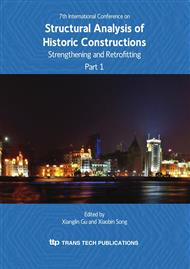[1]
(2004) Sika website. [Online]. Available: http: /www. sika. de/7205_sika_carbodur-lamelle. pdf/, Sika CarboDur - pultruded CFRP lamella for reinforcing RC structures.
Google Scholar
[2]
Blass, H J, Romani, M, and Schmid, M (2003). Optimierung von Verbundträgern aus Brettschichtholz mit Verstärkungen aus Faserverbundkunststoffen., Forschungsbericht Karlsruhe, Germany.
Google Scholar
[3]
Blass, R, and Kasal, B (2009). Modeling of composite layered laminated arches, in Proceedings from Computational Modeling and Advanced Simulations, Bratislava, Slovak Republic.
Google Scholar
[4]
Borri, A M, Corradi, A, Grazini (2005). A method for flexural reinforcement of old wood beams with CFRP materials., Composites Part B: Engineering, 36(2) 143-153.
DOI: 10.1016/j.compositesb.2004.04.013
Google Scholar
[5]
Clarke, J L, ed. (1996). EUROCOMP - Design Code and Handbook. Structural Design of Polymer Composites., E&FN SPON, London.
Google Scholar
[6]
DIN 1052: 2008-12. Design of timber structures - General rules and rules for buildings., Berlin, Germany.
Google Scholar
[7]
Haller, P (2007). Concepts for textile reinforcements for timber structures., Material and Structures. 40, 107-118.
DOI: 10.1617/s11527-006-9153-5
Google Scholar
[8]
Heiduschke, A, Haller, P (2008) Performance of composite-reinforced timber joints using single dowel-type fasteners, in 10th World Conf. on Timber Engineering, Miyazaki, Japan.
Google Scholar
[9]
Kasal, B (2004). Mechanical properties of wood., Book chapter in Encyclopedia of Forest Science, 1815-1828. Elsevier Publishing Co., Oxford, England. (Burley, J., J. Evans, and J. Younquist, Editors). ISBN 0121451207.
Google Scholar
[10]
Kasal, B, and Heiduschke A (2004) Radial reinforcement of glue laminated wood beams with composite materials., Forest Product Journal, 54 (1): 74-79.
Google Scholar
[11]
Kasal, B, and Heiduschke, A (2004). Radial reinforcement of glue laminated wood beams with composite materials., Forest Product Journal, 54 (1): 74-79.
Google Scholar
[12]
Kasal, B, Heiduschke, A, and Haller, P (2002). Fiber-reinforced beam-to-column connections for seismic applications, in Proceedings of CIB W18 meeting. 35-7-12, Kyoto, Japan.
Google Scholar
[13]
Kempe, O (2007). Ertüchtigung bestehender Holzkonstruktionen mit Hilfe faserverstärkter Kunststoffe" 7. Holzbauforum, Leipzig, Germany, HUSS Medien.
Google Scholar
[14]
Pizhong, Q J F, Davalos, M G, Zipfelh (1998). Modeling and optimal design of compositereinforced wood railroad crosstie., Composite Structures, 41( 1), 87-96.
DOI: 10.1016/s0263-8223(98)00051-8
Google Scholar
[15]
Tanaka, H, Ono, T, and Idota, H (2006). Evaluation of Buckling Strength of Hybrid Timber Columns Reinforced with Steel Plates and Carbon Fiber Sheets, in Proc. 9th WCTE. Portland.
Google Scholar


